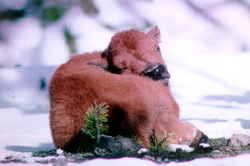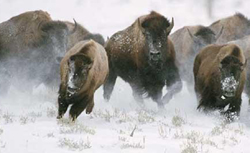Bison
Updated: August 10, 2020

The American Bison are also known as "buffalo," and their scientific name is Bovidae. The characteristics of the bison is its large size, shoulder hump, and short, dark, curved horns on both sexes. A mature bison bull may reach six feet in height at the shoulder, twelve feet in length, and may weigh up to one ton, while a mature bison cow will weigh approximately 1,100 lbs. They may look slow but bison can easily sprint up to thirty miles per hour. They are grazers and feed on grasses, forbs, and sedges. During the winter they use their massive heads to sweep away the snow from forage.
Bison can live 18 to 22 years and travel in herds of about 11 to 12 animals with the exception of older males which are solitry or in small groups. Males are considered mature by age 3. During the summer the bulls begin to mix with the cow-calf herds which stay together in herds throughout the year.

Cows mature between 2 to 4 years of age and give birth to calves mid-April to early June. Females will leave the herd and find a secluded place where vegetation provides cover for their babies, then rejoin the herd after the calf is about four days old. Calves can weigh up to forty pounds at birth. By late fall the cows start to wean the calves but the calves will stay with their mother until spring.
Before the 1800's, bison ranged throughout North America, mostly between the Rocky Mountains and the Mississippi River. They would migrate hundreds of miles in the spring and fall of each year, but now because of their limited habitat they migrate very little. They prefer short-grass prairies, but may also be found in the woods.

American bison were extremely important to the Plains Indians' way of life. Many tribes hunted bison as a source of food and shelter. Before they had horses the Plains tribes used buffalo jumps to harvest bison. Essentially bison were stampeded and herded off a cliff. Then the meat and skins were dried. There were uses for every part of the buffalo. Horns and hooves were boiled down for glue, sinew was used for sewing, and the skins were cured and stretched for clothing and teepees. Buffalo were a spiritual inspiration to Native Americans, there are many stories about them. The white buffalo, Big Medicine, was sacred to several tribes. Most Montana tribes keep buffalo on their land.
The great plains were once home to about 60 million bison, but with the arrival of settlers, the bison were pushed out of their native land and ruthlessly hunted. Prized for their meat and hides, and as trophies, bison were hunted almost to extinction; by 1891 the United States bison population had dwindled to less than 1,000 animals. When this was brought to the attention of President Theodore Roosevelt he petitioned Congress to create wildlife refuges, which were stocked with the few remaining buffalo. Additional bison were purchased from Canada. The recovery of American Bison has been remarkable. There are now thriving populations in Yellowstone Park and The National Buffalo Range.
Updated: August 10, 2020

